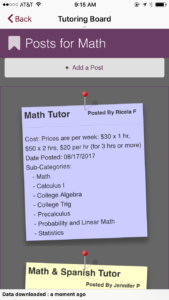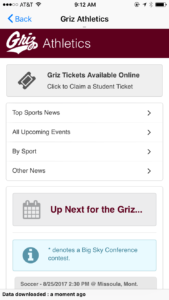A Deeper Look at Developing with campusM
By Payton Pietron, University of Montana
In this blog post, Payton further describes her experience as a student developer of the UMontana app built with campusM. Payton Pietron was a significant team member involved in the success of the UMontana app launch and has recently joined the Ex Libris campusM team as a Solutions Architect.
This post can also be found on the campusM blog.
As I have noted in a previous post, while enrolled at the University of Montana, I was hired as a student developer to help in the release of their new mobile platform, the UMontana app. I worked extensively with campusM’s Application Extension Kit (AEK), a powerful front-end tool.
Working as a student developer was the best undergraduate job I could have asked for. My experience was priceless. It provided me with the work experience I would need after graduation and it also got me involved in the University. I highly recommend that other universities provide the same opportunity to their students. Who better to develop services for students than a current student?
I started with minimal permissions, creating basic tiles and adding them to the demo app to be tested. These basic tiles would typically be one page and pull in data from an existing feed displayed as a clear and concise list of information. As my experience with the AEK grew, I was building APIs and consuming them with this powerful client-side tool.
I went on to create new tiles, like the Tutoring tile which just recently went live. It essentially acts as a matchmaker for students who want to provide tutoring services and students who are in need of those services. Another popular tile that I had a part in is the Grizzly Athletics tile. This tile consolidated all of the University’s sports information to one place. You can even get your student tickets from this service!
I also built other tiles such as Degrees and Majors, Events, and Student Groups. Since these services pertained to me as a student, I was actually using this app for the functionality it provided.
Given the range of options the AEK provides, the services mentioned are only a small part of what can be accomplished with this powerful SDK. campusM provides simple documentation on how to leverage this package and it only takes a few minutes to set up your environment.
The AEK was created for ease-of-use and this is made apparent when you begin developing. The documentation walks you through the library and gives you helpful examples on how you can use this kit. All these elements make using the AEK simple.
UM’s tech team has made a point of utilizing the simple tools provided by campusM and it is apparent in the result. The UMontana app has many unique tiles that were created in-house. UM has an innovative tech team that consistently generates useful services for the University. I consider myself lucky to have been able to use the AEK as part of such a collaborative and inventive team.
In all, my time as a student developer at the University of Montana pushed me to learn more and more about what can be done with the AEK. I had the freedom to create a myriad of tiles and functionalities. This is what the AEK gives you. You dictate the entire look and feel of the service you are creating. This tool is endlessly flexible and it promotes innovative development. I encourage development teams to dream up new services and start exploring their development with campusM’s AEK.
The post A Deeper Look at Developing with campusM appeared first on Ex Libris Initiatives.
Source: buki rss
Prijašnje verzije članka:
There are no revisions for this post.


